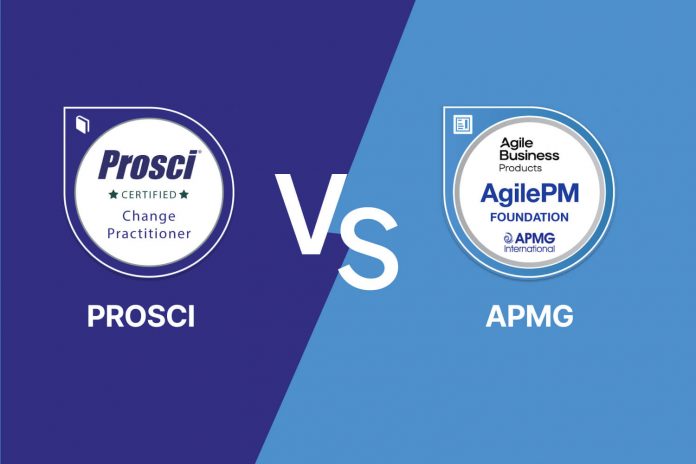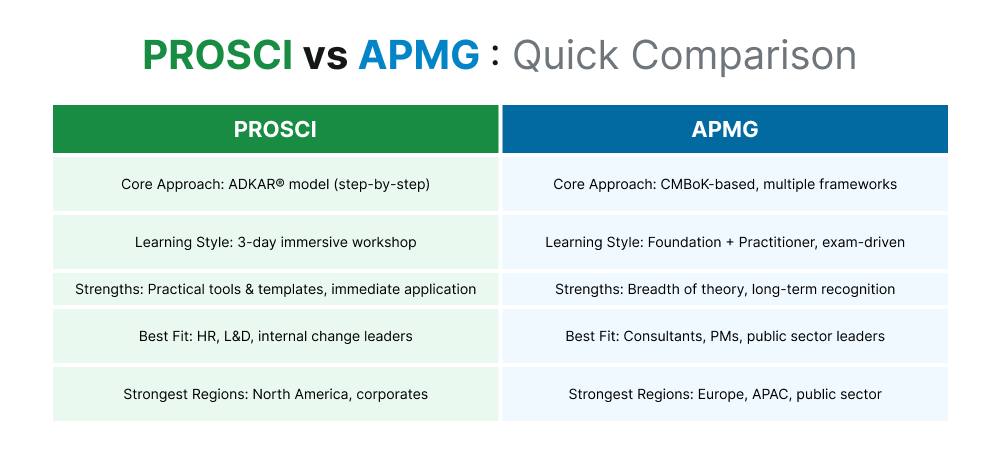
In an era where transformation has become a constant, organizations are placing greater emphasis on structured change management practices. Certifications in change management not only validate professional expertise but also provide a common framework for guiding people through complex transitions. Among the most recognized globally are the PROSCI Change Management Certification and the APMG Change Management Certification.
While both credentials are designed to strengthen an individual’s ability to lead change effectively, their focus, methodology, and recognition vary significantly. PROSCI is grounded in its research-driven ADKAR model, offering a highly practical approach widely adopted by corporations worldwide. APMG, accredited in collaboration with the Change Management Institute (CMI), offers a comprehensive competency-based framework that combines theory, governance, and practical tools, appealing to consultants, project managers, and enterprise leaders.
This comparison examines the distinct strengths of PROSCI and APMG, helping professionals identify which certification best aligns with their career objectives, organizational context, and the demands of their industry.
PROSCI Change Management Certification Overview
For professionals evaluating a change management credential, PROSCI Change Management stands out for one reason: it equips you with a clear, repeatable methodology that can be applied immediately inside an organization. Its ADKAR model – Awareness, Desire, Knowledge, Ability, and Reinforcement- has become one of the most recognized frameworks worldwide because it translates the complex process of change into a practical, people-focused roadmap.
From an organizational perspective, PROSCI is attractive to companies that want consistent adoption tools across projects. The certification doesn’t just teach theory; it provides templates, toolkits, and structured guides that enable practitioners to integrate change practices into their daily operations. This makes it especially valuable in fast-moving corporate environments where leaders are expected to show measurable progress quickly.
From an individual career perspective, PROSCI certification appeals to:
- HR, L&D, and transformation leaders who want a methodology that integrates seamlessly into project and people strategies.
- Managers and practitioners who need confidence applying change frameworks without having to “reinvent the wheel.”
- Professionals in multinational corporations, where PROSCI adoption is widespread and often specified in job descriptions.
Ultimately, PROSCI is best suited for professionals looking for a hands-on, practical approach that directly supports business outcomes. It helps answer the common question: “How do I move people through change in a structured, reliable way?”
Understanding APMG Change Management Certification
For professionals seeking a globally accredited, theory-backed credential, the APMG Change Management Certification provides a strong foundation. Developed in partnership with the Change Management Institute (CMI), it is grounded in the Change Management Body of Knowledge (CMBoK), a comprehensive reference that consolidates the principles, processes, and competencies expected of a change leader.
Unlike PROSCI’s single methodology, APMG does not prescribe a fixed model. Instead, it equips practitioners with a broad toolkit of theories, frameworks, and techniques to apply across different contexts. This makes it particularly valuable for professionals who need flexibility when working across industries, geographies, or governance structures.
From an organizational perspective, APMG certifications – Foundation and Practitioner, signal a structured, competency-driven approach to managing change. Many government agencies, consulting firms, and large enterprises value APMG’s exam-based rigor, as it assures stakeholders that certified professionals have mastered both the fundamentals and the ability to apply them in complex scenarios.
From an individual career perspective, APMG certification appeals to:
- Consultants and project/program managers who work on large-scale transformations across multiple clients.
- Professionals in the public sector, where APMG accreditation is particularly well recognized.
- Practitioners who prefer versatility, learning from multiple theories rather than adhering to a single proprietary model.
While APMG does not provide ready-made templates or step-by-step toolkits, it builds a methodical mindset that allows practitioners to design their own solutions. This is ideal for those who want to deepen their theoretical grounding and demonstrate credibility in formal, structured change environments.
APMG is best suited for professionals seeking a globally standardized certification that emphasizes governance, process discipline, and broad applicability across industries.
PROSCI vs APMG: Key Differences at a Glance
When choosing between PROSCI and APMG, professionals are deciding how they want to practice change management. PROSCI gives you a well-defined playbook. APMG provides a comprehensive body of knowledge and the credibility of global accreditation. Both open valuable doors, but the “right” choice depends on what you want to achieve with your certification.
1. The Nature of the Certification
- PROSCI: Built on the proprietary ADKAR model (Awareness, Desire, Knowledge, Ability, Reinforcement), PROSCI certification is a methodology-first approach. It teaches a structured, step-by-step process for leading individuals and organizations through change. Beyond theory, it equips you with ready-to-use templates, toolkits, and planning resources, which means you walk away with a consistent method you can apply across projects immediately.
- APMG: Based on the Change Management Body of Knowledge (CMBoK), APMG certification is knowledge-first. It does not prescribe a single methodology; instead, it introduces a broad range of frameworks, principles, and approaches from across the discipline. This gives professionals flexibility to adapt models depending on context, an advantage for consultants and leaders who operate across industries, but potentially overwhelming for newcomers who prefer a single, structured approach.
| ProTip: If you want a defined, repeatable playbook: PROSCI. If you prefer versatility across various contexts, consider APMG. |
2. The Learning Experience
- PROSCI: Delivered through an intensive 3-day workshop, PROSCI’s certification emphasizes experiential learning. Through case studies, role-play, and project-based simulations, participants actively build change plans using the ADKAR model. The program is designed for professionals who want to apply concepts in real time, making it highly practical and immersive.
- APMG: Structured as a two-stage pathway – Foundation (conceptual knowledge) and Practitioner (application through case scenarios), APMG follows an exam-based learning format. The Foundation ensures mastery of key concepts, while the Practitioner validates the ability to apply them in structured situations. The style is more academic and systematic, appealing to those who prefer staged learning and formal testing to demonstrate competence.
3. Recognition in the Market
- PROSCI: Particularly strong in corporate and multinational environments, especially across North America. Many organizations explicitly list PROSCI certification or familiarity with ADKAR as a requirement in job descriptions for HR, L&D, and transformation roles. For professionals aiming to work within large corporations, PROSCI often carries more weight because it is seen as a “plug-and-play” methodology.
- APMG: More widely recognized in Europe, Asia-Pacific, and the public sector, where formal accreditation and globally standardized exams are highly valued. In consulting, project management, and enterprise change environments, APMG signals breadth of knowledge and adherence to governance standards.
4. Alignment with Career Goals
- PROSCI: Ideal for professionals working inside organizations – HR leaders, L&D teams, internal change managers, and transformation leaders, who need a consistent methodology that can be adopted across departments and projects. It is best suited for roles where the expectation is to drive practical adoption rather than design frameworks.
- APMG: Tailored for consultants, project managers, program managers, and enterprise leaders who need to demonstrate broad competence across multiple change contexts. Since it draws from diverse models and is globally exam-validated, it provides transferable credibility that travels across industries and geographies.
Which Certification is Right for You?
Both PROSCI and APMG equip professionals to manage change effectively, but they do so in very different ways. The right choice depends less on the content of the course and more on your role, your environment, and your long-term goals.
When PROSCI Creates the Edge?
- Ideal if you need immediate structure and momentum in your role.
- Best for early or mid-career practitioners who want confidence and tools to start applying change practices quickly.
- Strong fit for projects with fixed timelines or compliance deadlines, where executives expect predictable adoption.
- Provides executive-friendly assurance, you can show results without building everything from scratch.
When APMG Builds Long-Term Value?
- Better suited for experienced managers, consultants, and program leaders who want to deepen their thinking.
- Equips you for emergent changes (in culture, behavior, or strategy shifts) that don’t follow linear project timelines.
- Signals strategic depth and credibility in regions and sectors where governance and formal accreditation matter.
- Strengthens your ability to integrate change management into broader organizational strategies.
Cost and Commitment as Deciding Factors
Budget and time availability also influence the choice.
- PROSCI requires a higher upfront investment, but it provides immediate access to resources that can enhance your effectiveness from day one.
- APMG requires more study discipline, particularly to progress from Foundation to Practitioner, but its total cost is lower and its credential holds long-term global recognition.
Why Some Professionals Choose Both?
Many seasoned change leaders eventually pursue both certifications, starting with PROSCI for operational confidence, then adding APMG later for breadth and career portability. This layered approach ensures you are equipped with both a practical toolkit and an academic foundation, giving you credibility across industries and geographies.
| If you need a certification that helps you deliver change tomorrow, PROSCI provides that head start. If you want a certification that strengthens your strategic depth and professional recognition over time, APMG is the stronger investment. |
Conclusion
There is no universal answer to which certification is “better”; it depends entirely on what you want to achieve.
- Choose PROSCI if you value a practical, structured methodology backed by ready-to-use templates and want to drive adoption quickly within your organization.
- Choose APMG if you prefer a broader grounding in change management theory, want long-term recognition, and plan to work across diverse industries or governance-heavy environments.
Both certifications carry significant weight in the global market, but neither guarantees success on its own. The real change management certification benefits come from how effectively you apply the knowledge, adapt it to your organizational context, and build credibility through consistent practice.
At Invensis Learning, we offer globally recognized Change Management Certification programs. Our expert-led training helps professionals not only earn the credential but also gain the practical insights needed to apply change management with confidence in real-world scenarios.















